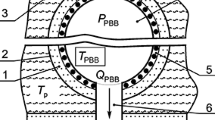Summary
It is shown that an iceblock with a hemispherical cavity can be used with good results as a convenient blackbody for the calibration, in the long-wave region, of ventilated radiation balance meters, i. e. in the work under consideration, theCourvoisier and theSchulze balance meters. For both these instruments it has been found that the sensitivity for long-wave radiation is approximately 20% less than for short-wave radiation using the sun as source; for theSchulze instrument the difference depends besides on solar altitude, a result which previously has been reported among others byAmbach, Beschorner andHoinkes [1]. It is further shown that theSchulze radiation balance meter should thermally be better insulated.
The results of the described calibration method seem to be confirmed by comparative measurements carried out in Hamburg. The results of the calibration, reported here, will have some bearing on the constants in the linear regression equation between atmospheric radiation and blackbody radiation at air temperature, given byH. Schieldrup Paulsen andK. A. Torheim [9, 10].
Zusammenfassung
Es wird gezeigt, daß ein Eisblock mit halbkugelförmiger Aushöhlung sich gut als Schwarzer Körper für die Eichung ventilierter Strahlungsbilanzmesser im Langwelligen eignet, wie sie in der vorliegenden Untersuchung für die Strahlungsbilanzmesser vonCourvoisier undSchulze durchgeführt wird. Für diese beiden Geräte hat sich gezeigt, daß bei Benützung der Sonne als Lichtquelle die Empfindlichkeit für langwellige Strahlung ungefähr 20% geringer ist als für kurzwellige; für das Instrument vonSchulze hängt dieser Unterschied auch von der Sonnenhöhe ab, was schon früher u. a. vonAmbach, Beschorner undHoinkes [1] festgestellt wurde. Auch ergab sich, daß dieses Instrument thermisch besser isoliert sein sollte.
Die Ergebnisse der hier beschriebenen Eichmethode scheinen durch Vergleichsmessungen in Hamburg ihre Bestätigung zu finden. Die hier besprochenen Eichresultate werden gewisse Konsequenzen für die Konstanten der linearen Regressionsgleichung zwischen atmosphärischer Strahlung und Schwarzkörperstrahlung bei Lufttemperatur haben, die vonH. Schieldrup Paulsen undK. A. Torheim [9, 10] angegeben wurden.
Résumé
On démontre ici qu'un bloc de glace portant une cavité hémisphérique convient bien comme corps noir pour l'étalonnage des appareils ventilés pour la mesure du bilan radiatif à longues ondes. Dans le cas présent, on en démontre l'efficacité pour les bilanmètres deCourvoisier et deSchulze. Il est apparu pour ces deux instruments que si l'on utilise le soleil comme source de lumière, la sensibilité est d'environ 20% inférieure pour le rayonnement à longues ondes que pour celui à ondes courtes. En outre, pour l'appareil deSchulze, cette différence dépend également de la hauteur du soleil, ce qui avait déjà été constaté antérieurement entre autres parAmbach, Beschorner etHoinkes [1]. Il est enfin apparu que cet appareil devrait être mieux isolé du point de vue thermique.
Les résultats des méthodes d'étalonnage décrites ici semblent être confirmés par des mesures comparatives effectuées à Hambourg. Les résultats d'étalonnage discutés ici auront certaines répercussions sur les constantes de l'équation de régression linéaire entre le rayonnement de l'atmosphère et celui d'un corps noir à la température de l'air, équation indiquée parH. Schieldrup Paulsen etK. A. Torheim [9, 10].
Similar content being viewed by others
References
Ambach, W., E. Beschorner, andH. Hoinkes: Über die Eichung des Strahlungsbilanzmessers nach R. Schulze. Arch. Met. Geoph. Biokl., B,13, 76 (1963).
Bertrand, R.: Preliminary Report on the Experimental Study of Various Radiation Balance Meters. Inst. Roy. Met. Belgique, Ronéogr., 1964.
Bolz, H. M., andG. Falckenberg: Neubestimmung der Konstanten der Ängströmschen Strahlungsformel. Z. f. Met.3, 97 (1949).
Dorsey, N. E.: Properties of Ordinary Water-Substance; p. 486. New York, 1940.
Drummond, A. J., H. W. Greer, andJ. J. Roche: The Measurements of the Components of Solar Short-Wave and Terrestrial Long-Wave Radiation. Solar Energy9, 127 (1965).
Kirillova, T. V., Y. K. Ross, andM. A. Sulev: Comparison of Balance Meters. Int. Rad. Symp. Leningrad, 1964 (Mimeographed).
Ross, Y. K., andM. Sulev: Some Results of the Comparison of Courvoisier. Schulze and Yanishevsky Balance Meters. Geof. pura e appl.53, 88 (1962).
Schieldrup Paulsen, H.: Über die Anwendung von künstlichen Belüftungseinrichtungen bei Strahlungsmeßgeräten. Ann. Met.8, 337 (1959).
Schieldrup Paulsen, H., andK. A. Torheim: On the Atmospheric Longwave Radiation. Proc. 3. Int. Congr. Int. Soc. Biomet. Pau, 1963 (in press).
Schieldrup Paulsen, H., andK. A. Torheim: Atmospheric Radiation in Bergen December 1957–June 1959. Årb. Univ. Bergen, No. 11, 1964.
Schulze, R.: Über die Verwendung von Polyäthylen für Strahlungsbilanzmessungen. Arch. Met. Geoph. Biokl., B,11, 211 (1961).
Schulze, R.: Bemerkung zu Ambach, Beschorner und Hoinkes. Arch. Met. Geoph. Biokl., B,13, 96 (1963).
Author information
Authors and Affiliations
Additional information
With 2 Figures
Rights and permissions
About this article
Cite this article
Schieldrup Paulsen, H. Some experiences with the calibration of radiation balance meters. Arch. Met. Geoph. Biokl. B. 15, 156–174 (1967). https://doi.org/10.1007/BF02319117
Received:
Issue Date:
DOI: https://doi.org/10.1007/BF02319117




